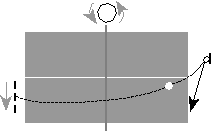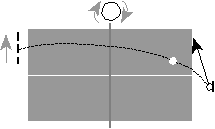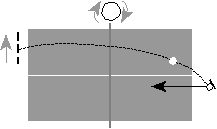|

UNDERSTANDING SPIN
Larry Thoman
Excerpts
from Newgy Robo-Pong 2000 Player's Instructional Manual
More so than any other sport, table tennis is a game of spin. In order to be
successful at table tennis, you must learn about and understand the
different types of spin and how to counteract the effects of these
spins on your racket.
There are two general ways to contact a ball with a racket. The
first is by using force; in other words, the racket is forced
through the path of the ball in a manner similar to hitting a
baseball with a bat. The primary result of force is forward
direction or speed. This is often the only way that beginners and
novice players have learned to contact a ball.
The second way to contact a ball is by using friction-to contact the
ball with a brushing motion so the rubber grabs the ball and makes
the ball rotate. The primary result of striking the ball using
friction is spin. The type of spin produced depends on the racket
angle and the direction the racket is traveling.
Top players primarily use friction to contact the ball. They apply
spin to almost every shot, sometimes severe amounts of spin. Robo-Pong
2000 simulates the play of a top player-it produces spin on
every shot it delivers. Untrained players often comment that the
robot's spin seems unusually strong. While this is true for an
untrained player, a trained, competitive player thinks the robot's
spin is quite normal. So if the spin seems strong at first, bear
with it and you'll soon adjust by following the suggestions and
lessons later in this manual. Table tennis is much more exciting and
dynamic when you can produce your own spin and control your
opponent's spin.
The figures below are simple explanations of the four major types of
spins-topspin, backspin, right sidespin, and left sidespin. Each
type of spin has two figures. The first figure shows what happens
when a particular spin contacts a vertical, still racket. The second
figure shows how to correct your racket angle to compensate for the
effect of the spin on your racket.
Topspin is normally produced by making your racket travel from low
to high while brushing the upper surface of the ball. Topspin has a
dipping effect on the flight of the ball. For this reason, a ball
carrying topspin can be hit with full force because the spin will
cause the ball to dip down and hit the table instead of going off
the end of the table. When the ball hits the table, the topspin
grabs on the table surface, which both compounds the dipping effect
and slightly increases ball speed. Topspin is considered to be
offensive in most cases.
When topspin strikes a vertical racket, the spin will grab on the
rubber surface and rebound upward, usually quite high and off the
far end of the table. To correct for
topspin and make the ball go back low over the net, tilt the leading
racket face down toward the table and contact the ball on its upper
surface. The more topspin on the ball, the more the racket needs to
be tilted down. (See Figures G
& H )
|

Figure G: Flight of Topspin Ball
Topspin is produced by racket traveling from low
to high, striking the ball on its upper surface.
Trajectory is arched. Ball dips after bouncing and
rebounds upward after striking a vertical racket.
|
|

Figure H: Correction for Topspin
Since topspin causes the ball to rebound up after
contacting a vertical racket, it is necessary to tilt the
leading racket face down toward the table and contact the
ball on its upper surface. The correct racket angle will
send the ball back low to the net. It is not necessary to
move the racket forward to make the ball go back across
the net.
|
|

Figure I: Flight of Backspin Ball
Backspin is produced by racket traveling from
high to low, striking the ball on its lower surface.
Trajectory is flat. Ball rises slightly after bouncing and
rebounds downward after striking a vertical racket.
|
|

Figure J: Correction for Backspin
Since backspin causes the ball to rebound down
when it strikes a vertical racket, it is necessary to tilt
the leading racket face up toward the ceiling and contact
the ball on its lower surface, sometimes actually on its
bottom. It is also necessary to add some forward direction
to your racket to make the ball go over the net.
|
An important fact to remember about topspin is it takes almost no
effort to counteract its effect on the racket. You only need to
angle the racket correctly. The topspin will cause the ball to go
back across the net on its own. No force needs to be applied to your
racket other than the effort it takes to tilt the racket.
Backspin is generated by making your racket travel from high to low
and brushing the ball on its lower surface. Backspin has a floating
or rising effect on the ball. When the ball hits the table, the
backspin grabs on the table, slowing the ball and making it rise
slightly. It's very difficult use full force when doing a backspin
return because the harder you hit it, the more it rises and it tends
sail off the far end of the table. Backspin is almost always
considered defensive.
When backspin strikes a vertical racket, the spin grabs onto the
rubber and the ball rebounds almost straight down. The ball seems to
die and lose all of its speed and spin. To correct for backspin, and
make the ball go back low over the net, Tilt the racket face up
toward the ceiling and contact the ball on its lower surface while
pushing the racket gently forward. The more backspin, the more the
racket must be tilted up and the more towards the bottom you must
contact the ball. (See Figures I & J )
Backspin is unlike topspin in that you must provide some forward
momentum to make your return clear the net. It is more difficult and
takes more energy to attack a ball with backspin because the ball
has a tendency to go down. The lifting action necessary to make the
ball clear the net takes away from the amount of forward force you
can apply when attacking a backspin ball.In general, a topspin ball
will be easier to attack than a backspin one. If you're a defensive
player, backspin should be your spin of choice because it makes it
harder for your opponent to attack forcefully. Right sidespin is
created when your opponent brushes his racket across the ball from
your right to your left. This spin has a curving effect on the
flight of the ball. After leaving your opponent's racket, the ball
will momentarily hook to your left, then curve to your right. When
it hits the table, the spin grabs, and the ball jumps out and curves
to your right.
When right sidespin strikes a vertical racket, the spin grabs onto
the rubber and jumps quickly to your left. To correct for right
sidespin, the leading racket face must be angled to the right and
you must contact the ball on its left surface. (See
Figures K & L )
Left sidespin is produced when your opponent brushes across the ball
with his racket from your left to your right. Left sidespin is
exactly like right sidespin, but in reverse. Left sidespin hooks to
your right, then curves to your left. When left sidespin hits a
vertical racket, it rebounds to the left. To correct for this spin,
angle your racket to the left and contact the ball on its right
surface. (See Figures M & N )
Sidespins are seldomly used in their pure form in table tennis.
Normally they are combined with topspin or backspin to produce a
combination spin such as right
sidespin/topspin or left sidespin/backspin. Combining two spins
produces the effects of both, but to a lesser degree than if they
were in their pure forms.
|
Figure
K: Flight of Right Sidespin Ball Right sidespin is produced by your opponent's
racket traveling from your right to your left. Trajectory
is curved. Ball curves to your right after bouncing. Ball
rebounds to your left after striking a vertical racket. |
 |
|
Figure
L: Correction for Right Sidespin Since right sidespin causes the ball to rebound
to the left when it strikes a vertical racket, it is
necessary to tilt the leading racket face to the right and
contact the ball to the left of its middle. |
 |
|
Figure M: Flight of Left Sidespin Ball Left sidespin is produced by your opponent's
racket traveling from your left to your right. Trajectory
is curved. Ball curves to your right after bouncing. Ball
rebounds to your right after striking a vertical racket. |
 |
|
Figure N: Correction for Left Sidespin
Since left sidespin causes the ball to rebound to
the left when it strikes a vertical racket, it is
necessary to tilt the leading racket face to the right and
contact the ball to the left of its middle. |
 |
For example, a ball with right sidespin/topspin will both dip and
curve to the right as it is comes toward you, particularly after it
bounces on your side. To correct for this combination spin, it is
necessary to contact the ball on its left upper surface by tilting
the racket down and angling it to the right.
Understanding spin and its effects is crucial to a player's success
in table tennis. The player with greater mastery of spin will almost
always control the play. By using spin, you can limit the responses
of your opponent and make him play your game. Two important table
tennis skills to develop are:
(1) Be able to instantly judge the type and amount of spin on the
ball. Deduce the type of spin by carefully watching the direction
your opponent's racket is traveling when it contacts the ball.
Deduce the amount of spin from the speed of your opponent's racket
at contact and the type of rubber being used. The faster your
opponent's racket is going at contact and the finer his graze of
the ball, the more spin he can apply to the ball.
Rubbers vary in their ability to spin the ball primarily because
of the grippiness of their top surface. In general, inverted
rubber is grippier and will produce more spin than pips-out
rubbers. But even within these two broad categories of rubber, the
spin producing capabilities of rubber will vary widely. If in
doubt, test the grippiness of an unknown rubber by running a ball
across its surface and comparing it to your own rubber.
(2) Once you determine the type and amount of
spin, be able to instantly adjust your racket angle to correct for
the spin's effect on your rubber. The tension of your grip, the
looseness of your wrist, the flexibility of your forearm, and the
position of your body all play major roles in developing this
important skill.
© 2000 - Newgy Industries - All Rights Reserved
|